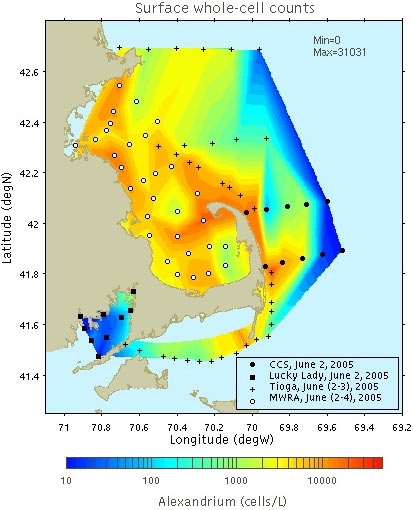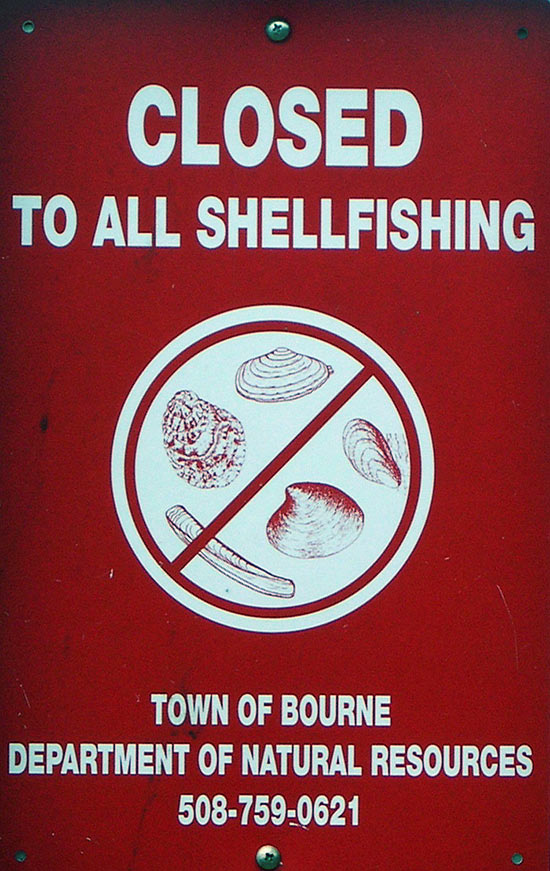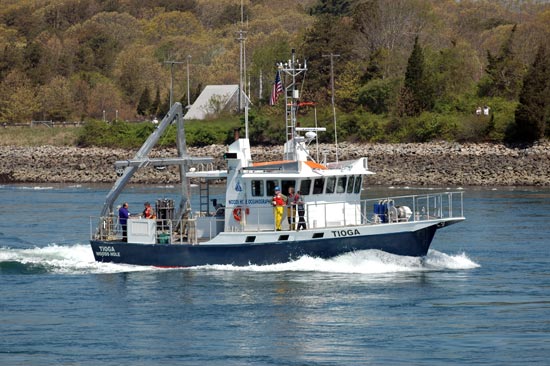2005 Bloom Season
Update: August 10, 2005
For the most part, the 2005 Alexandrium bloom appears to be winding down throughout southern New England. Many areas in New Hampshire and Massachusetts have re-opened for shellfish harvesting and some openings have also occurred in western Maine(Maine DMR site). Some locations still remain closed, however, and caution should therefore be exercised whenever shellfish are taken from this region’s waters. Be sure to check with state agencies and local officials to ascertain which areas are safe and which remain closed.
In some years, a fall outbreak of Alexandrium has occurred in the Gulf of Maine region. It is too soon to say whether this will happen in 2005. State agencies will continue to monitor shellfish throughout the remainder of the summer and into the fall to detect such a bloom, should it occur. Future updates will be provided here as well.
NOTE: This summary is provided for general informational purposes only. It should not be used to guide recreational and commercial shellfish harvesting decisions.
General Information
Spring 2005 brought the worst "bloom" of the toxic alga Alexandrium catenella since a massive outbreak occurred in 1972 in the New England region. These outbreaks are commonly called the red tide, but scientists prefer the term "harmful algal bloom" (or HAB). The term red tide includes many blooms which discolor the water but cause no harm, and ignores blooms of highly toxic cells that cause problems at low (and essentially invisible) cell concentrations.
Millions of microscopic plants (phytoplankton) thrive in nearly every drop of coastal seawater. In the presence of sunlight and sufficient nutrients to grow, these plants photosynthesize and multiply, creating a “bloom.” While most of the thousands of species of algae are harmless, this specific species is one of a few dozen that create potent toxins.
The swimming, photosynthetic cells of A. catenella are responsible for the bloom. These cells originate from the germination of dormant cysts that accumulate in bottom sediments and allow the species to survive cold winter temperatures and unfavorable growing conditions. The cysts and can also be resuspended by tides and storms.
The toxins produced by A. catenella accumulate in filter-feeding shellfish such as clams, mussels and oysters making them unsafe for people and animals to eat. There is no risk to people who consume the flesh of fish, lobsters, and shrimp or who swim in the ocean. If eaten in enough quantity, these contaminated shellfish can result in illness or even death from a poisoning syndrome called paralytic shellfish poisoning, or PSP. No cases of death attributed to PSP have been reported in New England, although this syndrome is associated with fatalities elsewhere in the U.S. and the world. Thus far there have been no human illnesses associated with the 2005 bloom.
The current A. catenella bloom began in the Gulf of Maine in early May and spread into Massachusetts and Cape Cod Bays. Coastal resource managers began closing shellfish beds in May for public health safety (see closure map), and by early June, the bloom took on massive proportions both geographically and in terms of cell abundancestretching from mid-Maine to Nantucket and Martha’s Vineyard and reaching cell concentrations tens to hundreds of times higher than normal. 15,000 square miles of federal waters out to Georges Bank have also been closed as a result of this historic outbreak (see map).
The waters on the south side of Cape Cod, so far, have not been affected and are being carefully monitored.
Scientists and coastal managers are concerned that under the right conditions the bloom could continue to spread southward along the southern Massachusetts, Rhode Island and Connecticut coasts into Long Island Sound. Since so many areas have experienced a red tide bloom for the first time this year, scientists are also concerned that these areas will be "seeded" for future blooms and are working to develop methods to forecast future outbreaks.
Scientists at Woods Hole Oceanographic Institution have been studying red tides for decades and have been monitoring the outbreak since early May, when they detected the extent and severity of the bloom in the Gulf of Maine during a cruise aboard the Institution's research vessel Oceanus. Since then regular sampling cruises have been conducted from the WHOI coastal vessel Tioga to check cell concentration levels to determine if the bloom has spread.
Data collected are shared with state and local officials who are responsible for public health decisions regarding closures of shellfish beds. WHOI researchers are working closely with federal officials as well, and have received event response funding for sampling cruises from NOAA's National Center for Coastal Ocean Science, Center for Sponsored Coastal Ocean Research, Other projects are underway through Woods Hole's Center for Oceans and Human Health and through Don Anderson's laboratory at WHOI.
Some Clues to the Causes of the Current Bloom
Alexandrium is naturally distributed throughout New England waters, and past research by Woods Hole Oceanographic Institution (WHOI) scientists has shown that these cells travel to the south in coastal currents derived from rivers and other water moving west in the Gulf of Maine. The algae typically develop into large-scale blooms only in waters off Maine and Canada, with intensities varying from year to year. Natural current and wind patterns usually keep the cells from flowing into nearshore waters of southern New England in most years.
There are some preliminary hints and clues to the causes of the massive bloom of 2005. The spring in New England was marked by unusual amounts of rain and snowmelt and by a steady pattern of northerly and easterly winds, capped by nor’easters on May 8 and May 24. The unusual weather likely pushed an abundance of Alexandrium cells south into Massachusetts Bay and Cape Cod Bay. Scientists speculate that there also may have been a larger source of cells in the Gulf of Maine at the start of the season, following an intense bloom off western Maine in autumn 2004.
The record-setting winter and spring precipitation also has flushed more fresh water and nutrients into the coastal region, creating prime conditions for the cells to grow and reproduce, and providing a buoyant transport pathway that carried cells down the coast. Finally, conditions this year may have favored a particular strain, or genotype, of Alexandrium in the western Gulf of Maine.
Why is the 2005 Bloom So Intense and Widespread?
The first observations of Alexandrium cells occurred during an expedition on the Institution's research vessel Oceanus from the edge of Boston Harbor to the middle of the Bay of Fundy in mid-May. A WHOI-led research team worked around the clock for nine days to collect nearly 500 water samples from 160 locations in the Gulf of Maine. The researchers surveyed and mapped the location of Alexandrium cells, using novel genetic probe techniques developed at WHOI to rapidly detect and quantify the amount of harmful algae in offshore waters. At the same time, researchers on the ship and at Dartmouth College provided oceanographic models of where ocean currents were likely to carry the cells.
The researchers detected a mother lode of Alexandrium on the western edge of the Gulf of Maine and in Massachusetts Bay, and they immediately notified shore-based colleagues and state officials who were already on alert because of toxicity reports from Maine and New Hampshire. After returning to Woods Hole, the researchers received federal emergency funding from the National Ocean Service Center for Sponsored Coastal Ocean Research to continue their surveys on the coastal vessel Tioga.
WHOI scientists have continued to work with state managers to collect and process cell count samples through the region, adding greatly to the information on the bloom which otherwise would have been limited to toxicity measurements along the shore. These sampling efforts have expanded to include zooplankton and fish as a result of several whale mortalities in the region that may be related to the massive bloom through food chain transfer of the toxins.
The Economic Cost of the Bloom
Social scientists have estimated that the red tide closures are costing the New England shellfish industry fishermen at least $3 million per week, while threatening the busy summer season for seafood restaurants and processors. It will take weeks to a month or more after the peak of the bloom for the shellfish to naturally purge the toxin from their tissues.
Nationally, blooms of all forms of harmful algae cost the United States at least $50 million per year, due to the death of wild and farmed fish, shellfish, submerged aquatic vegetation, and coral reefs, reductions in seafood sales and tourism, medical treatment of exposed populations, and the costs of monitoring programs to detect and quarantine toxic shellfish and other affected resources.
Media Briefings - July 14, 2005
Status of Bloom and Future Directions Officials from the National Oceanic and Atmospheric Administration (NOAA) and scientists from the Woods Hole Oceanographic Institution (WHOI) discussed the historic 2005 red tide outbreak in New England, current and future research, and possible implications for the future at two briefings for the media July 14, one held at the Massachusetts State House in Boston and the other at Woods Hole Oceanographic Institution. A symbolic check for $540,000 for continued research and ship time was presented by NOAA to WHOI during the Woods Hole briefing.
Speakers were:
Retired Navy Vice Admiral Conrad C. Lautenbacher, Jr.
Under Secretary of Commerce for Oceans and Atmosphere and NOAA Administrator
Kerry Healey
Massachusetts Lt. Governor (Boston Briefing Only)
James Luyten
Executive Vice President and Director of Research, Woods Hole Oceanographic Institution (Woods Hole Briefing Only)
Robert Magnien
Director, Center for Sponsored Coastal Ocean Research, NOAA Ocean Service
Kevin Chu
Special Assistant, Regional Administrator, NOAA Fishery Service, Northeast Office
Donald Anderson
Senior Scientist, Biology Department, Woods Hole Oceanographic Institution and
Director, U.S. National Office for Marine Biotoxins and Harmful Algal
Blooms
Publications
For more information on the 2005 A. catenella bloom, please see the following publication:

Mussel harvesting closure areas along the New England coast during 2005. Compiled from information provided by the Massachusetts Division of Marine Fisheries, the New Hampshire Department of Environmental Services, and the Maine Department of Marine Resources. (WHOI - D. Anderson laboratory)

Surface whole-cell hybridization counts of Alexandrium fundyense, June 2-4, 2005, from four survey cruises in Massachusetts Bay, Cape Cod Bay, Buzzards Bay, the outer Cape and the south side of Cape Cod. This image depicts the bloom near its maximum extent during the 2005 event. (D.M. Anderson laboratory, Woods Hole Oceanographic Institution)

Shellfish harvesting closure sign, Bourne, MA. (Photo by Judy Kleindinst, WHOI)

Coastal vessel Tioga heads through the Cape Cod Canal to sample waters of Massachusetts and Cape Cod Bays for red tide. (Photo by John Dyke, Woods Hole Oceanographic Institution)

NOAA Administrator Conrad Lautenbacher announced a $540,000 grant to WHOI at a Massachusetts State House news briefing July 14, 2005. Lt. Governor Kerry Healy is at left with other state officials. (Jayne Doucette/WHOI)

Senior Scientist Donald Anderson of the WHOI Biology Department presented an update on the historic bloom and future research directions. Anderson heads the U.S. National Office for Marine Biotoxins and Harmful Algal Blooms and is Director of the WHOI Coastal Ocean Institute. (Jayne Doucette/WHOI)
NOAA Press Release
Microsoft Word format
Don Anderson's Presentation at July 14, 2005 Media Briefing
PPT file
The Harmful Algae Page
Laboratory of Don Anderson
A WHOI Coastal Ocean Institute topic page, with links to articles and Web sites.
Maine Department of Marine Resources
May 26, 2005 news release
